
Shannon McCulloughPhD Chemistry, UNC Chapel Hill, 2018 B.S. Chemistry, College of William and Mary, 2013 |

|
First Author



The performance of dye-sensitized solar cells (DSSCs) depends on the properties and interactions of three fundamental components: the semiconductor, chromophore, and electrolyte. For the electrolyte, the dependence of DSSC performance on the identity and valence state of the spectator cation has not been well studied in p-type semiconductor systems, although the effects of these species in n-type TiO2 devices are significant, producing large shifts in semiconductor flat-band potential, charge-transfer kinetics, photocurrent, and open-circuit voltage (VOC). Here, we vary the spectator cation in p-type NiO DSSCs and demonstrate an increase in VOC by over 50% with two common redox couples. Using optimal cations, we achieved high VOC values without a significant reduction in photocurrent. Mott–Schottky analysis and electrochemical impedance spectroscopy reveal that the cation can shift the flat-band potential of NiO by nearly 1 V and substantially alter the lifetime of charge carriers and charge-transfer resistance at the semiconductor–electrolyte interface. Differences between the anionic and cationic redox couples employed suggest favorable and unfavorable interactions, respectively, with divalent cations at the NiO surface, causing increases and decreases in charge carrier recombination rate constants. Our results highlight the complex interaction between the semiconductor and electrolyte solution and indicate that varying the cation should yield immediate improvements in device metrics for most p-type DSSC systems.
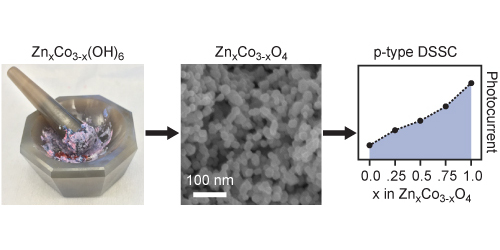
A solid-state mechanochemical synthesis of ZnxCo3−xO4 was developed with highly tunable Zn concentration. Photovoltaic performance was evaluated in dye-sensitized solar cells and tested with various Zn concentrations, exhibiting maximum performance with ZnCo2O4. Oxidative treatments led to a nearly three-fold increase in dye loading and a significant increase in short-circuit current density.
Contributing Author
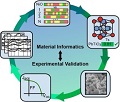


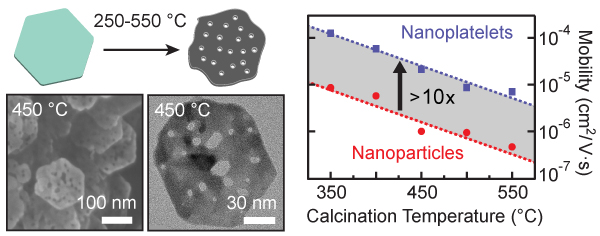
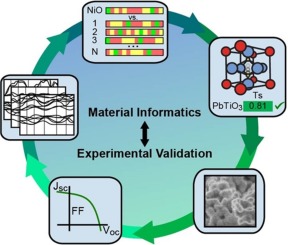
Materials informatics is a rapidly emerging data- and knowledge-driven approach for the identification of novel materials for a range of applications, including solar energy conversion. Despite significant experimental effort, the development of highly efficient, stable, and cost-effective photovoltaic materials remains a challenging scientific problem. The quest for precisely defined semiconductor properties revolves around an immensely broad landscape of structural parameters. Here, we have resolved this challenge by applying material informatics to design a novel photocathode material for dye-sensitized solar cells (DSSCs). By conducting a virtual screening of 50,000 known inorganic compounds, we have identified lead titanate (PbTiO3), a perovskite, as the most promising photocathode material. Notably, lead titanate is significantly different from the traditional base elements or crystal structures used for photocathodes. The fabricated PbTiO3 DSSC devices exhibited the best performance in aqueous solution, showing remarkably high fill factors compared to typical photocathode systems. The results highlight the pivotal role materials informatics can play in streamlining the experimental development of materials with the desired properties.
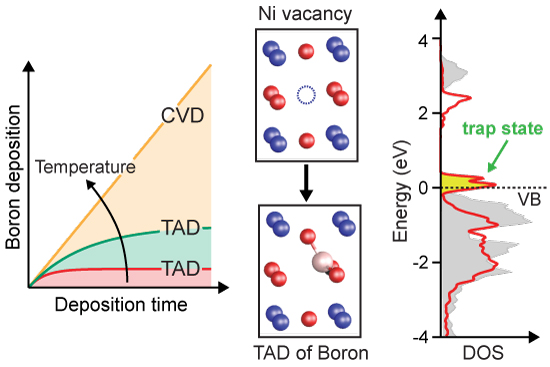
Localized trap states, which are deleterious to the performance of many solar-energy materials, often originate from the under-coordinated bonding associated with defects. Recently, the concept of targeted atomic deposition (TAD) was introduced as a process that permits the passivation of trap states using a vapor-phase precursor that selectively reacts with only the surface defect sites. Here, we demonstrate the passivation of nickel oxide (NiO) with the TAD process using diborane gas for selective, low-temperature deposition of boron (B) under continuous flow in a chemical vapor deposition (CVD) system. NiO is a ubiquitous cathode material used in dye-sensitized solar cells (DSSCs), organic photovoltaic devices, and organo-lead halide perovskite solar cells. The deposition of B at 100 °C is shown to follow first-order kinetics, exhibiting saturation at a B to Ni atomic ratio of ∼10%. Electrochemical measurements, combined with first-principles calculations, indicate that B passivates Ni vacancy defects by partially saturating the bonding of the oxygen atoms adjacent to the vacancy. p-Type DSSCs were fabricated using TAD-treated NiO and show a modest improvement in photovoltaic performance metrics. The results highlight the potential ubiquity of TAD passivation with a range of atomic precursors and vapor-phase processes.

ACS Applied Materials and Interfaces
For nanomaterials, surface chemistry can dictate fundamental material properties, including charge-carrier lifetimes, doping levels, and electrical mobilities. In devices, surface defects are usually the key limiting factor for performance, particularly in solar-energy applications. Here, we develop a strategy to uniformly and selectively passivate defect sites in semiconductor nanomaterials using a vapor-phase process termed targeted atomic deposition (TAD). Because defects often consist of atomic vacancies and dangling bonds with heightened reactivity, we observe—for the widely used p-type cathode nickel oxide—that a volatile precursor such as trimethylaluminum can undergo a kinetically limited selective reaction with these sites. The TAD process eliminates all measurable defects in NiO, leading to a nearly 3-fold improvement in the performance of dye-sensitized solar cells. Our results suggest that TAD could be implemented with a range of vapor-phase precursors and be developed into a general strategy to passivate defects in zero-, one-, and two-dimensional nanomaterials.

A p-type metal oxide with high surface area and good charge carrier mobility is of paramount importance for development of tandem solar fuel and dye-sensitized solar cell (DSSC) devices. Here, we report the synthesis, hierarchical morphology, electrical properties, and DSSC performance of mesoscale p-type NiO platelets. This material, which exhibits lateral dimensions of 100 nm but thicknesses less than 10 nm, can be controllably functionalized with a high-density array of vertical pores 4–6, 5–9, or 7–23 nm in diameter depending on exact synthetic conditions. Thin films of this porous but still quasi-two-dimensional material retain a high surface area and exhibit electrical mobilities more than 10-fold higher than comparable films of spherical particles with similar doping levels. These advantages lead to a modest, 20–30% improvement in the performance of DSSC devices under simulated 1-sun illumination. The capability to rationally control morphology provides a route for continued development of NiO as a high-efficiency material for tandem solar energy devices.